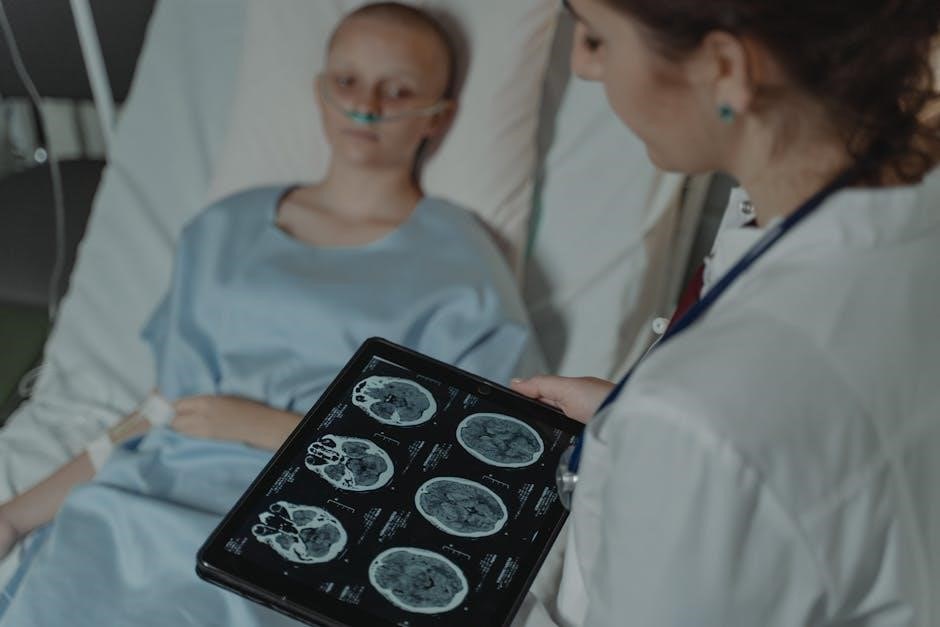The nursing curriculum serves as a comprehensive framework for educating future nurses, outlining core competencies, theoretical knowledge, and practical skills essential for effective patient care.
1.1 Definition and Key Terms
The nursing curriculum is a structured framework outlining educational objectives, competencies, and content essential for preparing future nurses. Key terms include theoretical foundations, clinical practice, simulation, patient safety, evidence-based practice, and cultural competence. These components ensure nurses are well-prepared to deliver high-quality care, addressing diverse patient needs effectively. Understanding these terms is crucial for curriculum development and implementation.
1.2 Importance of Curriculum Development in Nursing Education
Curriculum development in nursing education is vital to ensure nurses are prepared to meet evolving healthcare demands. It fosters critical thinking, clinical judgment, and evidence-based practices, enabling nurses to deliver high-quality care. A well-structured curriculum addresses real-world challenges, ensuring graduates are competent, compassionate, and ready to adapt to emerging healthcare trends and technologies.
Core Components of a Nursing Curriculum
A nursing curriculum includes theoretical foundations, clinical practice, simulation training, patient safety protocols, effective communication strategies, and cultural competence training to prepare nurses for diverse healthcare settings.
2.1 Theoretical Foundations
Theoretical foundations in nursing education provide the essential knowledge and principles that guide nursing practice, emphasizing critical thinking and evidence-based care. These foundations include nursing theories, ethical principles, and biophysical sciences, which are crucial for developing competent and compassionate nurses. They also address legal aspects and cultural competence, ensuring a holistic approach to patient care. Understanding these theories is vital for applying evidence-based practices and making informed clinical decisions.
2.2 Clinical Practice and Skills Development
Clinical practice and skills development are integral to nursing education, providing hands-on experience in real-world healthcare settings. Students engage in clinical rotations, honing technical skills like patient assessments, medication administration, and wound care. Simulation labs further enhance learning, allowing practice in controlled environments. These experiences foster critical thinking, decision-making, and ethical patient care, ensuring nurses are well-prepared for diverse clinical challenges and responsibilities.

Clinical Reasoning and Judgment
Clinical reasoning and judgment are essential skills for nurses, enabling them to analyze patient data, prioritize actions, and make informed decisions in dynamic healthcare environments.
3.1 Critical Thinking in Nursing Practice
Critical thinking in nursing practice involves analyzing patient data, identifying patterns, and evaluating evidence to make sound clinical decisions. Nursing curricula emphasize this skill to ensure nurses can prioritize care effectively and respond to complex scenarios with precision and confidence, ultimately enhancing patient outcomes and safety in diverse healthcare settings.
3.2 Case Studies and Real-Life Scenarios
Case studies and real-life scenarios are essential in nursing education, bridging theory and practice. They enable students to apply knowledge, develop critical thinking, and refine decision-making skills. These tools simulate actual clinical situations, allowing learners to explore diverse patient care challenges and outcomes, fostering preparedness for real-world healthcare environments and enhancing their ability to deliver effective, patient-centered care.
Simulation in Healthcare Education
Simulation in healthcare education mimics clinical environments, enhancing nursing skills and decision-making. It provides a safe space for practice, reducing real-patient risks while improving performance and preparedness.
4.1 Benefits of Simulation Training
Simulation training enhances clinical skills, decision-making, and teamwork. It provides a risk-free environment for nurses to practice, improving patient safety and preparedness. Simulation also allows for repeated practice, boosting confidence and competence in handling complex scenarios, ultimately leading to better healthcare outcomes and enhanced professional development.
4.2 Tools and Technologies Used in Simulation
Simulation employs advanced tools like high-fidelity mannequins, virtual reality, and augmented reality platforms. These technologies replicate real-life patient scenarios, enabling immersive learning experiences. Additionally, simulation software and wearable devices provide realistic feedback, allowing nurses to refine their skills in a controlled environment.

Patient Safety and Quality Care
Patient safety and quality care are integral to nursing education, emphasizing error prevention, evidence-based practices, and safe care delivery. Curricula promote health equity and reduce disparities, ensuring high standards and positive patient outcomes.
5.1 Patient Safety Curriculum Guide
A patient safety curriculum guide outlines essential competencies and strategies to ensure safe, high-quality care. It emphasizes error prevention, evidence-based practices, and effective communication, preparing nurses to address global health challenges with a multi-professional perspective.
Such guides promote health equity by reducing disparities and improving outcomes, ensuring nurses are well-equipped to deliver safe, compassionate care in diverse healthcare settings.
5.2 Strategies to Improve Healthcare Quality
Strategies to improve healthcare quality focus on evidence-based practices, critical thinking, and effective communication. Nurses are trained to implement standardized protocols, enhance patient outcomes, and reduce errors. These approaches emphasize continuous improvement, patient-centered care, and interprofessional collaboration, ensuring high-quality services that meet global healthcare standards and address diverse patient needs effectively.
Effective Communication in Nursing
Effective communication in nursing is vital for patient care, involving clear, empathetic interactions. It enhances patient understanding, trust, and outcomes, while fostering strong interprofessional teamwork and collaboration.
6.1 Overcoming Communication Barriers
Effective strategies to address communication barriers include active listening, using simple language, and cultural sensitivity. Nurses should employ tools like interpreters or visual aids to ensure clear understanding. Addressing these challenges fosters better patient engagement and improved clinical outcomes, ensuring equitable care delivery across diverse patient populations. Additionally, technology can aid in breaking down language and cultural obstacles, enhancing patient-provider interactions and overall care quality.
6.2 Role of Communication in Interprofessional Teams
Effective communication is vital within interprofessional teams, ensuring seamless collaboration and coordinated patient care. Nurses play a key role in articulating patient needs, sharing critical information, and maintaining clear dialogue with other healthcare professionals. This fosters a cohesive environment, enhances decision-making, and improves overall patient outcomes, emphasizing the importance of strong interpersonal skills in nursing education and practice.
Cultural Competence in Nursing Education
Cultural competence in nursing education fosters inclusive care by teaching nurses to respect and address diverse patient backgrounds, reducing health disparities and improving equitable health outcomes globally.
7.1 Promoting Health Equity
Promoting health equity involves addressing systemic disparities and ensuring all populations receive equitable care. Nursing education emphasizes cultural competence, enabling nurses to provide care that respects diverse backgrounds and needs, thereby reducing health inequities and improving outcomes for marginalized communities. This approach ensures inclusive, patient-centered care, fostering a more just and equitable healthcare system globally.
7.2 Addressing Health Disparities
Nursing education plays a crucial role in identifying and addressing health disparities by teaching students to recognize and mitigate factors contributing to unequal healthcare access and outcomes. Curricula incorporate strategies to improve cultural competence, language accessibility, and community engagement, enabling nurses to advocate for underserved populations and deliver care that bridges gaps in healthcare delivery and promotes social justice.
Evidence-Based Practice (EBP)
EBP integrates best research evidence, clinical expertise, and patient preferences to guide nursing decisions. It emphasizes critical appraisal of research, promoting quality care and improved patient outcomes.
8.1 Developing a PICOT Question
Developing a PICOT question involves defining Population, Intervention, Comparison, Outcome, and Time. This structured approach helps identify clinical research gaps, guiding evidence-based decisions and improving care quality.
8.2 Evaluating Patient and Nursing Staff Education
Evaluating education involves assessing knowledge retention, skill application, and patient outcomes. Evidence-based practices ensure effectiveness, while feedback mechanisms refine educational strategies, promoting continuous improvement in nursing care and patient safety.
NCLEX Preparation and Licensing
NCLEX preparation is crucial for nursing licensure, with state-specific requirements ensuring qualified professionals. The Nursing and Midwifery Council sets standards, verifying competence for safe practice.
9.1 Requirements for Registered Nurses
Registered nurses must meet specific standards set by the Nursing and Midwifery Council (NMC), including successful completion of the NCLEX exam. Educational requirements and clinical hours are verified, ensuring competence in patient care. State-specific licensing may add additional criteria, but the core focus remains on ensuring safe and effective nursing practice across all healthcare settings.
9.2 State-Specific Licensing Requirements
While the NCLEX exam is a universal requirement, licensing specifics vary by state. Some states may require additional exams, background checks, or training. For example, certain states mandate specialized certifications or continuing education in specific areas. Prospective nurses must check with their state’s nursing board to ensure compliance with all regional requirements for licensure.

The Role of AI in Nursing Education
AI is transforming nursing education by enhancing simulation training, offering personalized learning experiences, and fostering critical thinking through advanced tools and technologies.
10.1 AI Literacy for Nursing Students
AI literacy is essential for nursing students to understand and utilize AI tools effectively in healthcare. It involves recognizing AI’s role in patient data analysis, simulation training, and personalized learning. Ethical considerations and responsible use of AI in clinical settings are emphasized, preparing students to integrate AI technologies into future nursing practices seamlessly and ethically.
10.2 Prompt Engineering in Educational Contexts
Prompt engineering enhances AI’s effectiveness in nursing education by refining input prompts for precise, relevant outputs. It enables tailored learning materials, case simulations, and data analysis, fostering critical thinking and problem-solving skills. This technique ensures AI tools meet specific educational needs, aiding curriculum development and improving student engagement with complex nursing concepts through structured, optimized interactions.

Nursing Curriculum PDF Resources
Nursing curriculum PDFs provide accessible, detailed guides for education, offering structured frameworks, key concepts, and evidence-based practices for nursing students and educators to enhance learning outcomes effectively.
11.1 Accessing Nursing Curriculum Guides Online
Nursing curriculum guides in PDF format are widely available online through official nursing education websites, academic databases, and professional organizations. These resources provide comprehensive frameworks for nursing education, including theoretical foundations, clinical skills, and evidence-based practices.
Students and educators can access these guides by searching specific keywords like “nursing curriculum PDF” or visiting reputable platforms offering free or subscription-based access to educational materials.
11.2 Benefits of Digital Nursing Books and PDFs
Digital nursing books and PDFs offer numerous benefits, including portability, accessibility, and cost-effectiveness. They enable students to access curriculum materials anytime, anywhere, and are often more affordable than physical copies. Additionally, digital formats support interactive features like search functions and adjustable fonts, enhancing the learning experience. This makes them a valuable resource for modern nursing education.
- Portability and convenience
- Cost-effective and accessible
- Enhanced learning through interactive features
- Environmentally sustainable
Future Trends in Nursing Education
Future trends include innovations in curriculum design, emphasizing global health challenges, and integrating advanced technologies to prepare nurses for diverse, evolving healthcare needs worldwide.
12.1 Innovations in Curriculum Design
Innovations in nursing curriculum design are transforming education through personalized learning, simulation-based training, and AI integration. These advancements enhance critical thinking, clinical skills, and adaptability, preparing nurses for complex healthcare environments. Digital platforms and evidence-based practices further enrich the learning experience, ensuring future nurses are well-equipped to address global health challenges and deliver high-quality patient care.
12.2 Preparing Nurses for Global Health Challenges
Nursing education must address global health disparities, emphasizing cultural competence and collaboration. Curricula now incorporate strategies to prepare nurses for international crises, emerging diseases, and humanitarian efforts. By fostering a global perspective, nurses are equipped to navigate diverse healthcare systems, promoting health equity and delivering care in resource-limited settings effectively.

